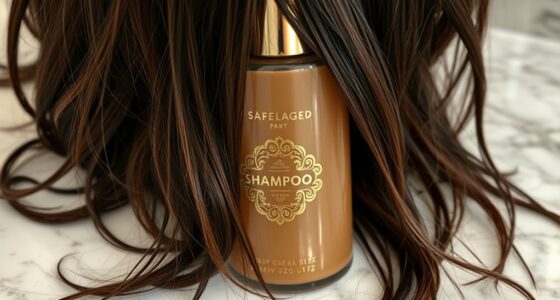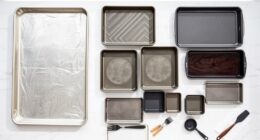Hairstylists avoid brushing wet hair because water weakens the internal bonds and makes the strands more fragile, increasing the risk of breakage, split ends, and damage. Brushing in this state can stretch or snap your hair, especially if you pull too hard or use the wrong tools. Instead, gently detangle using wide-tooth combs or your fingers, and apply leave-in conditioners to make detangling smoother. Keep going to learn safer techniques to protect your hair’s health.
Key Takeaways
- Wet hair’s internal bonds weaken and the cuticle becomes softer, increasing vulnerability to breakage when brushed.
- Brushing wet hair applies excessive force on fragile strands, leading to split ends and overall damage.
- Using the wrong tools, like fine-tooth brushes, can snag and snap wet hair, causing unnecessary breakage.
- Gentle detangling with wide-tooth combs or fingers minimizes stress and prevents damage during wet hair detangling.
- Post-shower, it’s better to gently dry hair with a microfiber towel and detangle carefully to maintain healthy hair.
The Fragility of Wet Hair
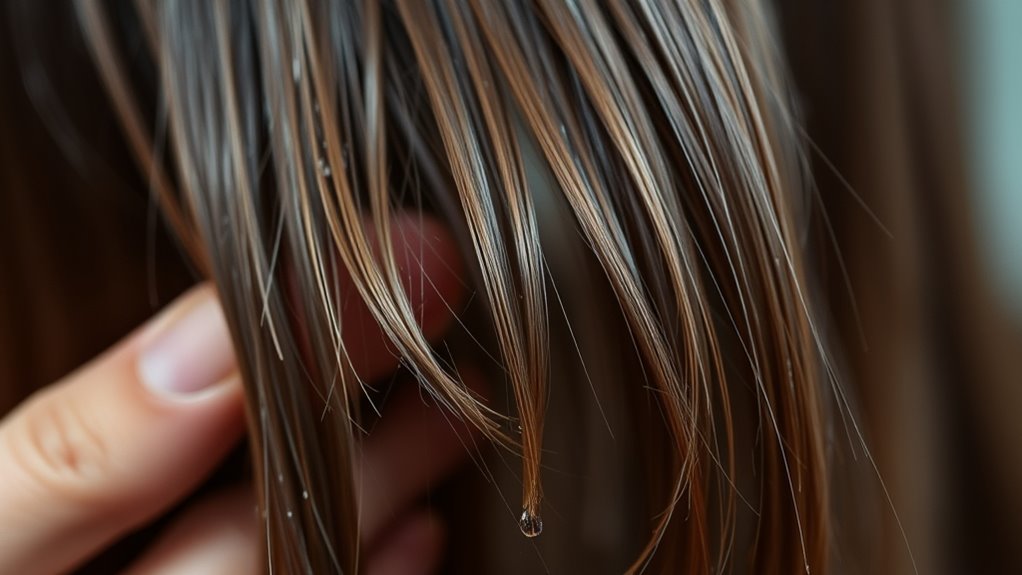
Wet hair is more fragile than dry hair because the water weakens the internal bonds that give hair its strength. When hair is wet, the keratin proteins lose their grip, making strands more prone to breakage. The outer cuticle layer also becomes softer and more vulnerable, increasing the risk of damage from pulling or brushing. This weakened state means your hair can’t withstand the same tension as when it’s dry. Even gentle handling can cause split ends or snapping. That’s why it’s essential to treat wet hair with care. Instead of brushing immediately, you should wait until it’s partially dry or use a wide-tooth comb to gently detangle. Protecting your hair during this delicate phase helps maintain its strength and health.
How Brushing Wet Hair Causes Damage

Brushing hair immediately after washing can cause significant damage because the comb or brush pulls on weakened, water-saturated strands. Wet hair is more elastic and fragile, making it prone to breakage. When you brush wet hair, you increase the risk of stretching and snapping these delicate fibers. This damage can lead to split ends and overall hair deterioration over time. To highlight this, consider the following:
| Damage Type | Cause |
|---|---|
| Breakage | Excessive pulling on wet hair |
| Split Ends | Frayed hair tips from tension |
| Thinning Hair | Repeated breakage over time |
Avoid brushing wet hair to prevent these issues. Instead, gently detangle with your fingers or use a wide-tooth comb once hair is slightly dry.
The Risks of Breakage and Split Ends
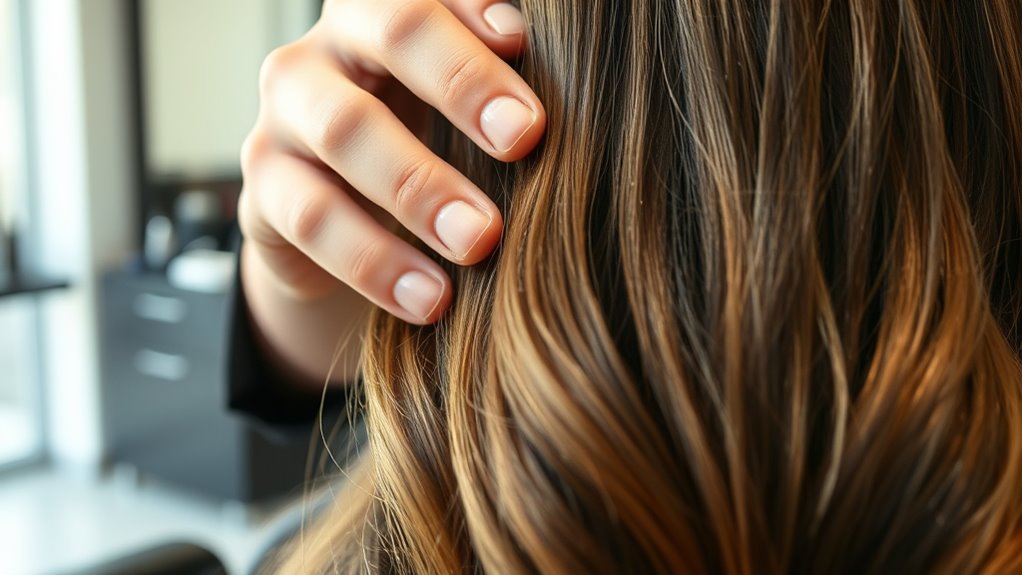
Wet hair is more vulnerable to breakage and split ends because it’s weaker and less resilient. When you pull or brush it too roughly, you risk damaging the strands and causing splits to form. Over time, this weakens your hair and makes it harder to maintain healthy, smooth locks. Additionally, couples traveling together often face unique challenges that can impact their relationship, much like how improper hair care can affect hair health. To protect your hair, it’s best to use a wide-tooth comb and gentle techniques when detangling wet hair, especially considering the damage caused by rough handling. Using a high-quality detangling tool designed for wet hair can further minimize this risk and help maintain your hair’s integrity.
Increased Hair Breakage Risks
When hair is damp, it becomes more vulnerable to damage, making it easier to experience breakage and split ends. Wet strands lose their strength and elasticity, so brushing or combing can cause the fibers to snap or weaken. Using excessive force or rough brushes breaks the fragile cuticles, leading to more breakage over time. This damage isn’t always visible immediately but can cause your hair to appear frizzy, dull, and thin. Repeatedly stressing wet hair accelerates the deterioration of your strands, increasing the risk of split ends and breakage that can travel up the hair shaft. To protect your hair, avoid aggressive brushing when wet and opt for gentle detangling methods to minimize damage and maintain healthier, stronger hair. Regular use of conditioning products can also help in maintaining moisture and reducing fragility for healthier hair.
Split Ends Formation
Split ends form when the protective outer layer of your hair, the cuticle, becomes damaged and begins to peel away. This damage often occurs from rough handling, excessive heat, or chemical treatments. When the cuticle is compromised, the hair becomes dry, brittle, and more prone to splitting. As the split progresses, it can travel up the hair shaft, weakening the overall strand and increasing breakage risk. You might notice tiny, frayed tips or feel a rough texture on your ends. If left untreated, split ends can make your hair look dull and damaged. Preventing split ends also involves protecting your hair from environmental stressors that can weaken the cuticle, much like how self-watering planters help maintain optimal moisture levels for plants. Additionally, proper hair care routines can help reinforce the cuticle and prevent damage. For example, using gentle handling techniques and avoiding vigorous brushing when your hair is wet can significantly reduce damage. Proper hair care helps keep your cuticle intact and reduces the chances of split ends forming, especially when you use protective styling methods.
Weakened Hair Strands
Damaged hair strands are more vulnerable to breakage and splitting, especially when subjected to daily stressors. When your hair is weakened, even gentle brushing can cause damage, leading to fragile strands that snap easily. Wet hair is particularly susceptible because water weakens the internal bonds, making the outer cuticle more vulnerable. As a result, your hair becomes more prone to split ends and breakage from routine activities like combing, styling, or brushing. Over time, this damage accumulates, diminishing your hair’s strength and appearance. To protect your strands, avoid aggressive brushing when wet, and instead, opt for gentle detangling methods. Proper care helps maintain your hair’s integrity, reduces breakage, and prevents further weakening of your hair strands. Additionally, understanding GMC tuning can help you optimize your vehicle’s performance, similar to how proper hair care optimizes your hair’s health. Using the right hairbrush designed for wet hair can also significantly minimize damage and maintain your hair’s vitality. Recognizing the importance of indoor air quality and how it affects health underscores the need to handle your hair with care, especially in environments that may contribute to damage.
Common Mistakes When Detangling Wet Hair
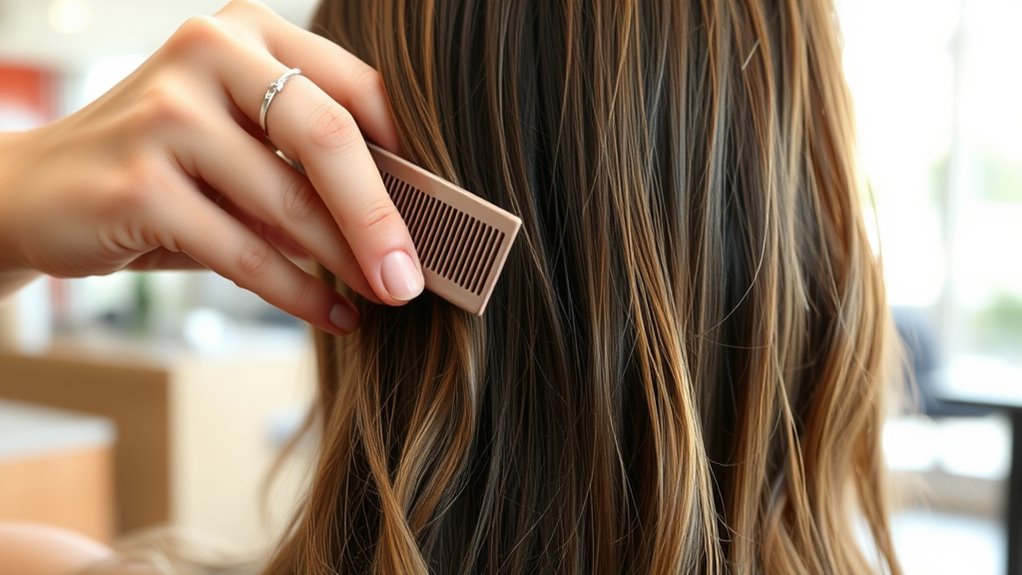
Detangling wet hair can seem straightforward, but many people make common mistakes that can cause damage or make the process more difficult. You might yank or pull too hard, which weakens strands and causes breakage. Using a regular brush instead of a wide-tooth comb can also lead to unnecessary stress on your hair. Rushing through detangling without patience can create more knots and damage. Detangling from roots to ends without gentle care can cause split ends. Ultimately, neglecting to apply a conditioner or detangling spray reduces slip, making knots harder to manage. To avoid these mistakes, take your time, use the right tools, and be gentle. Proper technique prevents damage and keeps your hair healthy and strong.
Safer Alternatives for Detangling
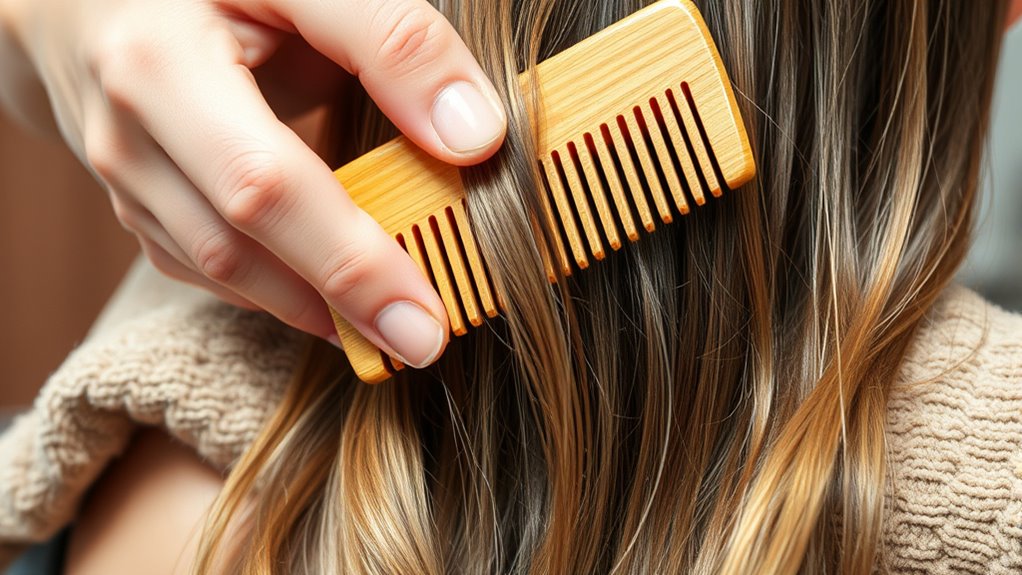
To minimize damage when detangling wet hair, try using gentle tools like wide-tooth combs or detangling brushes. Applying a leave-in conditioner can also help slip through tangles more easily. These safer alternatives make the process smoother and protect your hair from unnecessary breakage. Additionally, understanding the importance of hair care tools and nurturing relationships can inspire patience and care during your hair care routine. Using the right hairbrushes can further reduce stress on delicate strands and improve overall hair health. Using gentle detangling techniques can also prevent damage and promote healthier hair growth.
Gentle Detangling Tools
When it comes to managing wet hair, using gentle detangling tools can make a significant difference in preventing breakage and damage. The right tools help you untangle without pulling or stressing strands. Look for wide-tooth combs or brushes specifically designed for wet hair, as they glide smoothly through damp locks. Avoid fine-tooth brushes that can snag and snap hair. Consider tools with flexible bristles that bend and adapt to your hair’s shape. Using your fingers to gently loosen knots before detangling also reduces stress on your hair. Incorporating protective styling techniques can further safeguard your hair during detangling, especially if you often experience hair breakage or damage. Choosing tools made from sustainable and eco-friendly materials aligns with current trends and supports overall hair health. Additionally, selecting high-quality detangling tools can contribute to gentler handling and better hair maintenance over time. Being mindful of hair porosity can help you choose the appropriate products and techniques for optimal results.
Use of Leave-in Conditioners
Leave-in conditioners are excellent safer alternatives for detangling wet hair because they help reduce friction and smooth the strands, making it easier to work through knots without causing damage. They coat your hair with a lightweight layer of moisture and slip, which minimizes pulling and breakage. When applying, spray or distribute the conditioner evenly from roots to tips, focusing on tangled areas. Use your fingers or a wide-tooth comb to gently work through knots, allowing the product to loosen and separate strands. Unlike brushing wet hair, which can cause breakage, leave-in conditioners provide the lubrication needed for gentle detangling. Incorporating them into your routine helps maintain your hair’s health while making the process more manageable and less damaging. Additionally, using appropriate tools designed for wet hair can further reduce the risk of damage during detangling. For optimal results, choose a leave-in conditioner formulated for damaged or fragile hair, as it offers extra protection and nourishment during detangling. Proper detangling techniques and the use of gentle handling practices can also significantly decrease hair breakage and preserve your hair’s integrity. Using a properly formulated leave-in conditioner can also help protect against environmental damage and heat styling, especially when combined with floating on water inspired protective strategies to prevent unnecessary stress on wet strands.
Best Practices for Hair Care After Showering

After you finish showering, gently blot your hair with a microfiber towel or soft cotton T-shirt to remove excess water without causing damage. This helps prevent breakage and cut down on frizz. Once your hair is damp but not dripping, avoid rubbing vigorously. Instead, apply a leave-in conditioner or detangler to help manage tangles and add moisture. Use a wide-tooth comb to gently detangle from ends to roots. Don’t squeeze or twist your hair; let it air-dry naturally whenever possible. If you need to blow-dry, use the lowest heat setting and keep the dryer moving. Remember, handling wet hair carefully minimizes damage and keeps your strands healthy. Incorporating AI-powered tools can also assist in analyzing your hair type and recommending personalized care routines.
Tips for Maintaining Healthy, Strong Hair

Maintaining healthy, strong hair requires consistent care and mindful habits. To do this, focus on gentle handling, proper hydration, and nourishing your scalp. Use sulfate-free shampoos, avoid excessive heat styling, and incorporate regular trims to prevent split ends. Also, consider adding deep conditioning treatments to restore moisture and strength. Remember, your hair reflects your overall health, so eat a balanced diet and stay hydrated. Here’s a simple guide to understanding key factors:
| Factor | Impact |
|---|---|
| Proper Hydration | Keeps hair elastic and less prone to breakage |
| Gentle Handling | Prevents damage from harsh brushing or styling |
| Nutritional Health | Supports hair growth and strength |
Frequently Asked Questions
Can I Use a Regular Brush on Wet Hair?
You might wonder if you can use a regular brush on wet hair. While it’s tempting, using a standard brush can cause breakage and damage because wet hair is more fragile. Instead, opt for a wide-tooth comb or a brush designed for wet hair. Gently detangle from the ends upwards, and avoid tugging or pulling to keep your hair healthy and prevent unnecessary breakage.
Does Air-Drying Hair Reduce Damage From Brushing?
Think of air-drying as gently letting your hair’s roots breathe after a long day. Yes, it can reduce damage from brushing because your hair stays less fragile and more resilient. When you air-dry, you avoid breaking the hair’s delicate cuticles that are vulnerable when wet. Just be patient—rushing the process with a rough brush can undo this benefit. So, embrace air-drying for healthier, less damaged hair.
Are There Specific Hair Types That Tolerate Brushing When Wet?
Some hair types tolerate brushing when wet better than others. If your hair is thick, curly, or coarse, you might find it more resistant to damage when wet, but still proceed with caution. Fine or damaged hair, however, is more fragile and should be handled gently or detangled with a wide-tooth comb. Always use a gentle technique and avoid vigorous brushing to prevent breakage, regardless of your hair type.
How Often Should I Replace My Detangling Tools?
Think of your detangling tools as loyal friends that need regular check-ups. You should replace your detangling brush or comb every six to twelve months, depending on how often you use it. Over time, they accumulate hair, dirt, and bacteria, making them less effective and potentially damaging your hair. Regular replacement guarantees smooth, healthy detangling sessions and keeps your scalp happy and free from unnecessary breakage.
What Products Help Protect Hair During Detangling?
To protect your hair during detangling, use a leave-in conditioner or a detangling spray that adds slip and reduces breakage. Applying a lightweight oil or serum can also help smooth strands and make combing easier. Always start detangling from the ends and work your way up gently. These products and techniques prevent damage, keep your hair hydrated, and make the process more comfortable and effective.
Conclusion
Remember, brushing wet hair is like trying to tame a wild tornado—it’s bound to cause damage. Instead, embrace gentle detangling methods and use the right tools to keep your hair strong and healthy. With patience and proper care, you’ll transform your hair from fragile to fierce. Don’t let your hair suffer the relentless chaos of improper brushing—treat it with kindness, and it’ll reward you with shine and strength beyond your wildest dreams.



